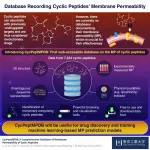(Press-News.org) Water in California’s Central Valley contains enough manganese to cause cognitive disabilities and motor control issues in children, and Parkinson’s-like symptoms in adults.
A naturally occurring metal, manganese is found in water supplies throughout the world. It is regulated as a primary contaminant in many Southeast Asian countries where the climate causes it to leach into groundwater. However, in the U.S. it is regulated only as a secondary contaminant, meaning no maximum level is enforced.
A new UC Riverside-led study shows that, among Central Valley communities, the highest concentrations of manganese are in private, untreated well water systems. However, the researchers also found it in public water systems at higher concentrations than what studies have shown can have adverse health effects.
The study, published in the journal Environmental Science & Technology, not only measured levels of manganese in Central Valley water supplies, but also mapped the highest concentration areas according to annual income levels.
Overall, the research team estimates nearly half of all domestic well water users in the Central Valley live in disadvantaged communities, as defined by annual income. Within this population, nearly 89% have a high likelihood of accessing water that is highly contaminated with manganese.
“It is a relatively small number of people, compared to the total population of the state, who are getting the tainted water. But for them, the health risks are high,” said Samantha Ying, UCR soil scientist and principal study investigator. “These people are particularly concentrated in disadvantaged communities, so if they wanted to monitor and treat the water, they would have a hard time doing so,” Ying said.
Point-of-use treatment options range from oxidation and precipitation filters to water softeners, chlorination, and reverse osmosis systems. But devices for monitoring water quality can cost up to $400 annually, and treatments for manganese-tainted water are just as expensive.
“It is possible to purchase filters for manganese, but a lot of people cannot afford them. We are hoping people in these communities can be subsidized to buy treatment options,” Ying said.
Previously, the research team found that manganese-contaminated groundwater tends to occur in relatively shallow depths, compared to arsenic. They wondered if digging deeper wells would avoid the manganese contamination. Unfortunately, that strategy is unlikely to be effective.
“Using existing groundwater model predictions of manganese concentrations at deeper depths did not change the number of wells likely to be contaminated,” Ying said.
The conditions that cause arsenic and manganese to leach are similar, so they tend to show up in groundwater in tandem. Arsenic has long been regulated as a primary contaminant in the U.S. “Wells are labeled unsafe if they contain arsenic, but not if they contain manganese,” Ying said. “Thus, the number of wells considered safe may be greatly overestimated.”
Furthermore, the researchers used a benchmark of 300 parts per billion of manganese to assess water quality. This is a level of manganese contamination that some studies have associated with neurological development issues, particularly for fetuses and infants during early growth periods. It is likely though that adverse effects can occur at lower levels.
“New studies from Canada, where manganese is now a primary contaminant, show there may be effects at 100 parts per billion,” Ying said. “We were being conservative at 300.”
This study focused on the Central Valley in part because the conditions that cause manganese to move from aquifer materials into water are so prevalent there. It is likely that drinking water from wells in other parts of the state is similarly tainted. Over 1.3 million Californians rely on unmonitored private wells.
“The population being exposed is much bigger than we might think. There are a lot of communities statewide drinking from private wells,” Ying said.
END
Manganese in Central Valley water threatens fetuses and children
Contamination disproportionately harming lower-income communities
2023-04-05
ELSE PRESS RELEASES FROM THIS DATE:
Do altered gut microbes affect risk of attention-deficit/hyperactivity disorder?
2023-04-05
New research published in the Journal of Child Psychology and Psychiatry suggests that the microbial composition of the gut may affect a child’s susceptibility to attention-deficit/hyperactivity disorder (ADHD).
The human gastrointestinal tract hosts a large population of microorganisms such as bacteria, viruses, and fungi. When investigators compared fecal samples from 35 children with ADHD and 35 healthy controls, samples from children with ADHD had higher levels of certain species of fungi and lower levels of other species.
In experiments with cells grown in the lab, one species in abundance in ...
Can a drug used to treat liver disease help prevent SARS-CoV-2 infections and lessen COVID-19 severity?
2023-04-05
SARS-CoV-2, the virus that causes COVID-19, attaches to a cellular receptor called angiotensin-converting enzyme 2 (ACE2), and activation of the farnesoid X receptor increases ACE2 expression. New research published in the Journal of Internal Medicine suggests that a drug that inhibits the farnesoid X receptor and is used to treat liver disease may decrease SARS-CoV-2 infections and reduce the severity of COVID-19.
The study ran from March 2020 to February 2022 and included 3,214 patients with liver disease, half of whom were taking the drug, called ursodeoxycholic acid (UDCA). ...
Can some snakes do cartwheels to escape or startle predators?
2023-04-05
In research published in Biotropica, investigators report that the Dwarf Reed Snake (Pseudorabdion longiceps) performs cartwheels when threatened. This is the first time such an active rolling motion has been documented in snakes, with images and a detailed description.
The Dwarf Reed Snake is a nocturnal, small snake that lives in regions of Southeast Asia. Typical defense mechanisms that small snakes use against predators include fleeing, camouflage, coloration, odors, death-feigning, and intimidation. ...
Can phototherapy improve cognitive function in patients with dementia?
2023-04-05
In an analysis of published clinical trials, investigators found that phototherapy—or exposure to sessions of bright light—may be a promising non-pharmacological intervention for lessening symptoms of dementia.
The analysis in Brain and Behavior included 12 randomized clinical trials. Results indicated that phototherapy improved cognitive function in patients with dementia, but it did not affect symptoms of depression or sleep quality.
“Further well-designed studies are needed to explore the most effective clinical implementation ...
Could a novel small molecule slow or reverse the effects of Duchenne muscular dystrophy?
2023-04-05
In a new study published in The FASEB Journal, investigators demonstrated the potential of a molecule that may help overcome some of the devastating symptoms of Duchenne muscular dystrophy (DMD), the most common life-limiting congenital neuromuscular disorder. The agent promotes the activity of AMP-activated protein kinase (AMPK), an important fuel-sensing enzyme that is present in all mammalian cells.
Previous research has shown that stimulating AMPK can mitigate the dystrophy—or wasting—of muscles, but AMPK activators have failed to reach the clinic due to either their lack of potency or toxic off-target effects.
In ...
CycPeptMPDB: A database aimed at promoting drug design using cyclic peptides
2023-04-05
CycPeptMPDB, a novel database—created by Tokyo Tech researchers—focused on the membrane permeability of cyclic peptides, could accelerate the development of drugs based on these promising compounds. This database was created by gathering published information on thousands of cyclic peptides and organizing it neatly in an online-accessible platform. Thanks to its search and visualization capabilities, CycPeptMPDB could pave the way to new computational and machine learning methods for screening and designing drugs with cyclic peptides.
One of the ...
Brain injury toolkit helps support domestic violence survivors
2023-04-05
COLUMBUS, Ohio – A new approach to trauma-informed care developed by domestic violence survivor advocates and researchers at The Ohio State University has been found in a new study to improve support organizations’ care for survivors by better recognizing brain injury and addressing its often long-lasting repercussions.
The study appears in the Journal of Head Trauma and Rehabilitation.
CARE is the first trauma-informed approach that considers brain injury in the complex set of circumstances to be addressed and accommodated in order ...
Aging at AACR Annual Meeting 2023
2023-04-05
Impact Journals (Aging's publisher) is proud to participate at the American Association for Cancer Research (AACR) Annual Meeting 2023, which convenes April 14-19 in Orlando, Florida.
BUFFALO, NY-April 4, 2023 – Impact Journals will be participating as an exhibitor at the American Association for Cancer Research (AACR) Annual Meeting 2023 from April 14-19 at the Orange County Convention Center in Orlando, Florida. This year, the AACR meeting theme is: “Advancing the Frontiers of Cancer Science and Medicine.”
Impact ...
A cold-specialized icefish species underwent major genetic changes as it migrated to temperate waters, new study finds
2023-04-05
Many animals have evolved to tolerate extreme environments, including being able to survive crushing pressures of ocean trenches, unforgiving heat of deserts, and limited oxygen high in the mountains. These animals are often highly specialized to live in these specific environments, limiting them from moving to new locations. Yet, there are rare examples of species that once lived in harsh environments but have since colonized more temperate settings. Angel Rivera-Colón, a former graduate student now postdoc in the lab of Julian Catchen (CIS/GNDP), an associate professor in the department ...
Bacterial signaling across biofilm affected by surface structure
2023-04-05
Similar to how cells within human tissues communicate and function together as a whole, bacteria are also able to communicate with each other through chemical signals, a behavior known as quorum signaling (QS). These chemical signals spread through a biofilm that colonies of bacteria form after they reach a certain density, and are used to help the colonies scavenge food, as well as defend against threats, like antibiotics.
“QS helps them to build infrastructure around them, like a city,” ...
LAST 30 PRESS RELEASES:
Norbert Holtkamp appointed director of Fermi National Accelerator Laboratory
New agentic AI platform accelerates advanced optics design
Biologists discover neurons use physical signals — not electricity — to stabilize communication
Researchers discover that a hormone can access the brain by hitchhiking
University of Oklahoma researcher awarded funding to pursue AI-powered material design
Exploring how the visual system recovers following injury
Support for parents with infants at pediatric check-ups leads to better reading and math skills in elementary school
Kids’ behavioral health is a growing share of family health costs
Day & night: Cancer disrupts the brain’s natural rhythm
COVID-19 vaccination significantly reduces risk to pregnant women and baby
The role of vaccination in maternal and perinatal outcomes associated with COVID-19 in pregnancy
Mayo Clinic smartwatch system helps parents shorten and defuse children's severe tantrums early
Behavioral health spending spikes to 40% of all children’s health expenditures, nearly doubling in a decade
Digital cognitive behavioral treatment for generalized anxiety disorder
Expenditures for pediatric behavioral health care over time and estimated family financial burden
Air conditioning in nursing homes and mortality during extreme heat
The Alps to lose a record number of glaciers in the next decade
What makes a good proton conductor?
New science reporting guide published for journalists in Bulgaria
New international study reveals major survival gaps among children with cancer
New science reporting guide published for journalists in Turkey
Scientists develop a smarter mRNA therapy that knows which cells to target
Neuroanatomy-informed brain–machine hybrid intelligence for robust acoustic target detection
Eight SwRI hydrogen projects funded by ENERGYWERX
The Lundquist Institute and its start-up company Vitalex Biosciences Announces Strategic Advancement of Second-Generation fungal Vaccine VXV-01 through Phase 1 Trials under $40 Million Competitive Con
Fine particles in pollution are associated with early signs of autoimmune disease
Review article | Towards a Global Ground-Based Earth Observatory (GGBEO): Leveraging existing systems and networks
Penn and UMich create world’s smallest programmable, autonomous robots
Cleveland researchers launch first major study to address ‘hidden performance killer’ in athletes
To connect across politics, try saying what you oppose
[Press-News.org] Manganese in Central Valley water threatens fetuses and childrenContamination disproportionately harming lower-income communities

